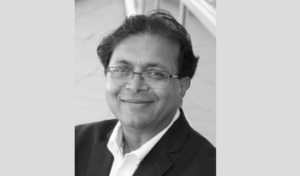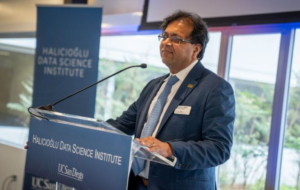

The University of California, San Diego, has long been at the forefront of high performance computing (HPC), thanks to the San Diego Supercomputer Center. With the creation of a new school dubbed the School of Computing, Information and Data Sciences (SCIDS), which is headed up by Interim Dean Rajesh Gupta, UCSD is fast becoming a leader in applied data science too.
We recently caught up with Gupta, who in addition to being a professor at UCSD and director of the Halicioglu Data Science Institute (HDSI) is also a BigDATAwire Person to Watch for 2025. Here’s what he said:
BigDATAwire: First, congratulations on your selection as a 2025 BigDATAwire Person to Watch! You’re the interim dean of the new SCIDS school that was created last year by the union of the San Diego Supercomputer Center (SDSC) and the Halıcıoğlu Data Science Institute (HDSI). How has the transition going so far?
Rajesh Gupta: The transition has been smooth so far as my attention has shifted from the day-to-day operation of HDSI to strategic planning for the new School. Both units of the new School are well-functioning organizations with ambitious growth plans that give us new opportunities to leverage mutual strengths.
BDW: Today’s GenAI technology is moving so fast that you can’t turn to college textbooks to learn about it, which you have pointed out. What is SCIDS’ secret for staying on top of this fast-moving area?
RG: It is the “people”. SDSC has an extraordinary collection of experienced researchers and engineering professionals. When you compliment them with 42 new researchers, out of which 37 are assistant professors, you have likely the largest collection of active young talent in Artificial Intelligence areas working together anywhere in the country.
BDW: Where are the greatest needs for data science curriculum at the moment? Where are the gaps in student education?
RG: Data Science curriculum often finds itself at an intersection of areas – from computing, cognition to mathematics and domain sciences – where tough choices have to be made for a program that would stand the test of time. We have opted to ensure strong fundamentals interspersed with practical applications right from the lower division of our program (https://datascience.ucsd.edu/current-students/course-descriptions-and-prerequisites/).
The most significant gaps are seen in our entering students: they are drawn from different backgrounds and varying levels of basic math or computing preparations. A significant part of student advising and preparation is to navigate through the courses that suit their backgrounds. We are in the sixth year of our undergraduate and the third year of our graduate programs. Despite this experience, the right-sized curriculum with the right amount of mathematical and computer science preparation background is still a work in progress. In the coming years, we should see many teaching materials and textbooks that formalize this training.

Rajesh Gupta, distinguished professor of computer science and engineering, during a June 2024 ceremony celebrating the opening of a new building for the UC San Diego’s Halıcıoğlu Data Science Institute (Image courtesy UCSD)
At the undergraduate level, we ensure that our students are encouraged to pursue their domain interests right from the beginning of the program by giving early practical skills and ensuring that all required courses are completed by the end of the junior year. That way, seniors pursue electives of interest and their capstone projects. At the graduate level, especially for doctoral students, we ensure that the students understand and complete GRR (generalizability, responsibility, and reproducibility) requirements.
BDW: UCSD has become one of the top data science schools in the country over the past decade. How will the college continue to stay in that upper echelon?
RG: There are two key elements of our strategy to ensure the quality of our programs: (a) our classes are designed and taught by leading experts and active researchers in the specific technical areas; and (b) closer collaboration and engagement with our industry partners, specifically active practitioners of Data Science who have direct practical experience. For (a), we have to ensure that we have the full breadth of topical areas of data science subjects covered by our faculty, a feat that we have already accomplished by creating one of the largest concentrations of talent in Data Science in the country. For (b), our industry partners serve as mentors and teachers to our students, holding office hours and supervising project groups for our seniors.
BDW: What can you tell us about yourself outside of the professional sphere – unique hobbies, favorite places, etc.? Is there anything about you that your colleagues might be surprised to learn?
RG: Outside of running, I love photography. As technology evolves, photography moves towards more creative elements that seek emotive responses in ways light interacts with the expressions. I love to play around with the camera and subjects. My favorite places vary: for fond memories, nothing beats the Bay Area, where I first arrived as a graduate student forty years ago. I spent some time in INRIA Rennes in Brittany, France, and EPFL in Switzerland. Both are my favorites for a trip anytime. I write short stories that do what I tried with pictures, capture moments, and generate emotive responses. Maybe someday, I will find time to pursue these interests full-time.
To read the rest of the interviews with the 2025 BigDATAwire People to Watch, click here.
June 20, 2025
- Couchbase to be Acquired by Haveli Investments for $1.5B
- Schneider Electric Targets AI Factory Demands with Prefab Pod and Rack Systems
- Hitachi Vantara Named Leader in GigaOm Report on AI-Optimized Storage
- H2O.ai Opens Nominations for 2025 AI 100 Awards, Honoring Most Influential Leaders in AI
June 19, 2025
- ThoughtSpot Named a Leader in the 2025 Gartner Magic Quadrant for Analytics and BI Platforms
- Sifflet Lands $18M to Scale Enterprise Data Observability Offering
- Pure Storage Introduces Enterprise Data Cloud for Storing Data at Scale
- Incorta Connect Delivers Frictionless ERP Data to Databricks Without ETL Complexity
- KIOXIA Targets AI Workloads with New CD9P Series NVMe SSDs
- Hammerspace Now Available on Oracle Cloud Marketplace
- Domino Launches Spring 2025 Release to Streamline AI Delivery and Governance
June 18, 2025
- WEKA Introduces Adaptive Mesh Storage System for Agentic AI Workloads
- Zilliz Launches Milvus Ambassador Program to Empower AI Infrastructure Advocates Worldwide
- CoreWeave and Weights & Biases Launch Integrated Tools for Scalable AI Development
- BigID Launches 1st Managed DPSM Offering for Global MSSPs and MSPs
- Starburst Named Leader and Fast Mover in GigaOm Radar for Data Lakes and Lakehouses
- StorONE Unveils ONEai for GPU-Optimized, AI-Integrated Data Storage
- Cohesity Adds Deeper MongoDB Integration for Enterprise-Grade Data Protection
- Fivetran Report Finds Enterprises Racing Toward AI Without the Data to Support It
- Datavault AI to Deploy AI-Driven Supercomputing for Biofuel Innovation
- Inside the Chargeback System That Made Harvard’s Storage Sustainable
- What Are Reasoning Models and Why You Should Care
- The GDPR: An Artificial Intelligence Killer?
- It’s Snowflake Vs. Databricks in Dueling Big Data Conferences
- Databricks Takes Top Spot in Gartner DSML Platform Report
- Snowflake Widens Analytics and AI Reach at Summit 25
- Why Snowflake Bought Crunchy Data
- Top-Down or Bottom-Up Data Model Design: Which is Best?
- Change to Apache Iceberg Could Streamline Queries, Open Data
- Fine-Tuning LLM Performance: How Knowledge Graphs Can Help Avoid Missteps
- More Features…
- Mathematica Helps Crack Zodiac Killer’s Code
- It’s Official: Informatica Agrees to Be Bought by Salesforce for $8 Billion
- Solidigm Celebrates World’s Largest SSD with ‘122 Day’
- AI Agents To Drive Scientific Discovery Within a Year, Altman Predicts
- DuckLake Makes a Splash in the Lakehouse Stack – But Can It Break Through?
- The Top Five Data Labeling Firms According to Everest Group
- ‘The Relational Model Always Wins,’ RelationalAI CEO Says
- Who Is AI Inference Pipeline Builder Chalk?
- Data Prep Still Dominates Data Scientists’ Time, Survey Finds
- IBM to Buy DataStax for Database, GenAI Capabilities
- More News In Brief…
- Astronomer Unveils New Capabilities in Astro to Streamline Enterprise Data Orchestration
- Yandex Releases World’s Largest Event Dataset for Advancing Recommender Systems
- Astronomer Introduces Astro Observe to Provide Unified Full-Stack Data Orchestration and Observability
- BigID Reports Majority of Enterprises Lack AI Risk Visibility in 2025
- Databricks Unveils Databricks One: A New Way to Bring AI to Every Corner of the Business
- MariaDB Expands Enterprise Platform with Galera Cluster Acquisition
- FICO Announces New Strategic Collaboration Agreement with AWS
- Snowflake Openflow Unlocks Full Data Interoperability, Accelerating Data Movement for AI Innovation
- Databricks Announces Data Intelligence Platform for Communications
- Cisco: Agentic AI Poised to Handle 68% of Customer Service by 2028
- More This Just In…



























